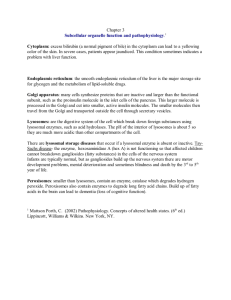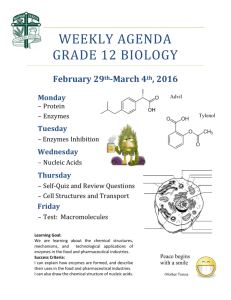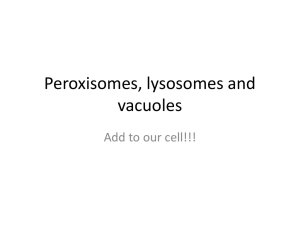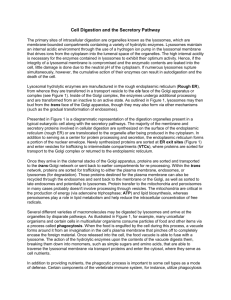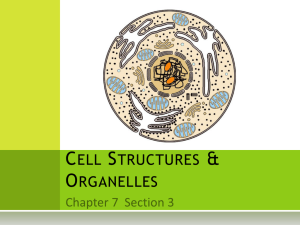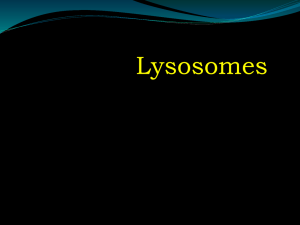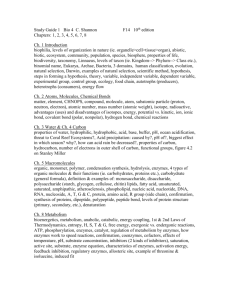- M.Sc Zoology
advertisement
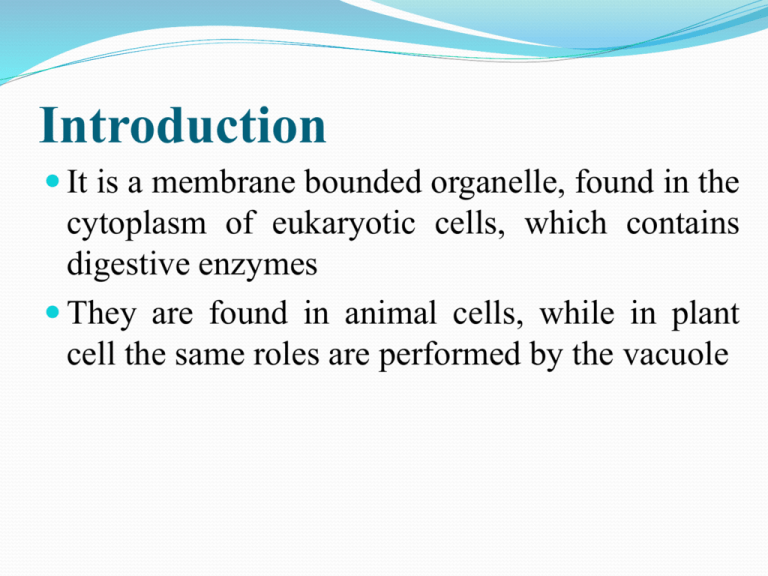
Introduction It is a membrane bounded organelle, found in the cytoplasm of eukaryotic cells, which contains digestive enzymes They are found in animal cells, while in plant cell the same roles are performed by the vacuole Cont... Lysosomes were discovered by the Belgium cytologist Christian de Duve in 1955, and named as "suicide bags" or "suicide sacs“. They are most abundant in cells which are related with the enzymatic reactions such as liver cells pancreatic cells, kidney cells, spleen cells, leucocytes, macrophages etc. Structure of Lysosome Lysosomes are surrounded by a single membrane unique in composition. The membrane contains highly glycosylated lysosomal associated membrane proteins (LAMP) and lysosomal integral membrane proteins (LIMP). That constitute about 50% of all lysosomal membrane proteins. Cont... LAMPs and LIMPs form a coat on the inner surface of the membrane, and are thought to protect the membrane from attack by the numerous hydrolytic enzymes retained within lysosomes. Cont... The lysosomal membrane also harbours a proton pump that utilizes the energy from ATP hydrolysis to pump H+ into the lumen, there by creating the acidic pH characteristic of lysosomes. Cont... The primary function of lysosomes is degradation of extra and intra cellular material. For this purpose, lysosomes are filled with hydrolases. Which may contain about 40 varieties of enzymes. The lysosomal enzymes are classified into Several types namely. Cont... Proteases, which digest proteins. Lipase, which digests lipids. Amylase, which digest carbohydrates (e.g., sugars). Nucleases, which digest nucleic acids. phosphoric acid monoesters. Cont... The lysosomal enzymes are collectively called as hydrolases. The hydrolases cleavage of substrates by the addition of a water molecules. Most of the lysosomal enzymes function in the acid medium. Hence they are called as acid hydrolases. Cont... Lysosome Production Lysosomes are manufactured and budded into the cytoplasm by the Golgi apparatus with enzymes inside. The enzymes that are within the lysosome are made in the rough endoplasmic reticulum, which are then delivered to the Golgi apparatus via transport vesicles. TYPES Primary lysosome are small saclike structures enclosing enzymes synthesized by the rough endoplasmic reticulum. Since they store enzymes, they are also said to be storage granules. Secondary lysosome are formed by the fusion of primary lysosome with phagosomes. Cont... The Secondary lysosome contain engulfed materials and enzymes. The materials are progressively digested by the enzymes. digestive vacuole. So it is also called as Function: Heterophagy. Program cell death. Autophagy. Autolysis. Fertilization. Chromosomal damage. Heterophagy Heterophagy is the lysosomal digestion of extracellular materials by the process of endocytosis. Heterophagy are of two types namely Phagocytosis. Pinocytosis. Program cell death Given their high levels of hydrolytic enzymes, lysosomes are potentially harmful to the cell. partial and selective lysosomal membrane permeabilization (LMP) induces controlled cell death. LMP provokes the translocation of lysosomal contents to the cytoplasm. Cont... The proteases implicated in cell death are cathepsins that remain active at neutral pH, such as cathepsin B, C,D, and cathepsin L These proteases trigger and cascade the essential organelle of cell, which led to cell death. Autophagy Autophagy is a normal physiological process in the body that deals with destruction of cells in the body. It maintains homeostasis or normal functioning by protein degradation and turnover of the destroyed formation. cell organelles for new cell Autolysis Autolysis refers to the digestion of own cells by the lysosomes. In autolysis, the lysosome digests its own cell Autolysis occurs during amphibian metamorphosis, and insect metamorphosis etc. Fertilization During fertilization process, acrosome (giant lysosome) of sperm head ruptures and releases enzymes on the surface of the egg. These enzymes digest the egg membrane and provide way for the entry of sperm nucleus into the egg. Chromosomal damage Due to the presence of DNase enzyme, lysosome had an ability to attacks chromosome and cause chromosomal breakages. These breakages can leads to diseases like cancer etc. Peroxisomes Peroxisomes are organelles found in nearly all eukaryotic cells. Their existence was first discovered by J. Rhodin in 1954 and they were officially considered organelles in 1967 by Christian de Duve. Simple membrane-bound vesicles with 0.1 - 1.0 µm diameter Often have dense, crystalline core of an oxidative enzyme(s) & consequently granular appearance Multifunctional organelles containing >50 enzymes involved in diverse activities like: Oxidation of very long chain fatty acids (VLCFAs); whose chains typically contain 24 – 26 C Peroxisomes Synthesis of plasmalogens Abnormalities in plasmalogen synthesis can lead to severe neurological dysfunction Luciferase which generates light emitted by fireflies, is also a peroxisomal enzyme Peroxisomes Named peroxisomes since they are the site of synthesis & degradation of H2O2 H2O2 is produced by a number of peroxisomal enzymes Urate oxidase, glycolate oxidase & amino acid oxidases that utilize molecular oxygen to oxidize their respective substrates Catalase (at high concentration in peroxisomes) rapidly breaks down H2O2 generated in these reactions Peroxisomes Form by splitting from preexisting organelles Import preformed proteins from cytosol Do similar kinds of oxidative metabolism in mitochondria Alanine/glyoxylate aminotransferase, is seen in the mitochondria of some mammals (cats, dogs) & peroxisomes of others (rabbits, humans) Glyoxysomes A specialized type of peroxisome found only in plants Contain some of same enzymes (catalase, fatty acid oxidase), but others as well Plant seedlings rely on stored fatty acids to provide energy & material to form new plant Glyoxylate cycle Glyoxysomes A primary metabolic activity in these germinating seedlings is the conversion of stored fatty acids to carbohydrate Stored fatty acid disassembly produces acetyl CoA & it condenses with oxaloacetate to form citrate Citrate is then converted to glucose by a series of glyoxylate cycle enzymes found in glyoxysomes
